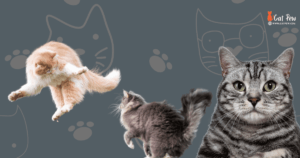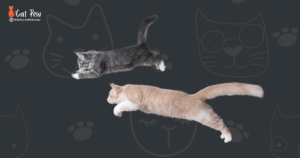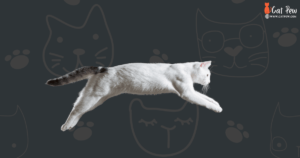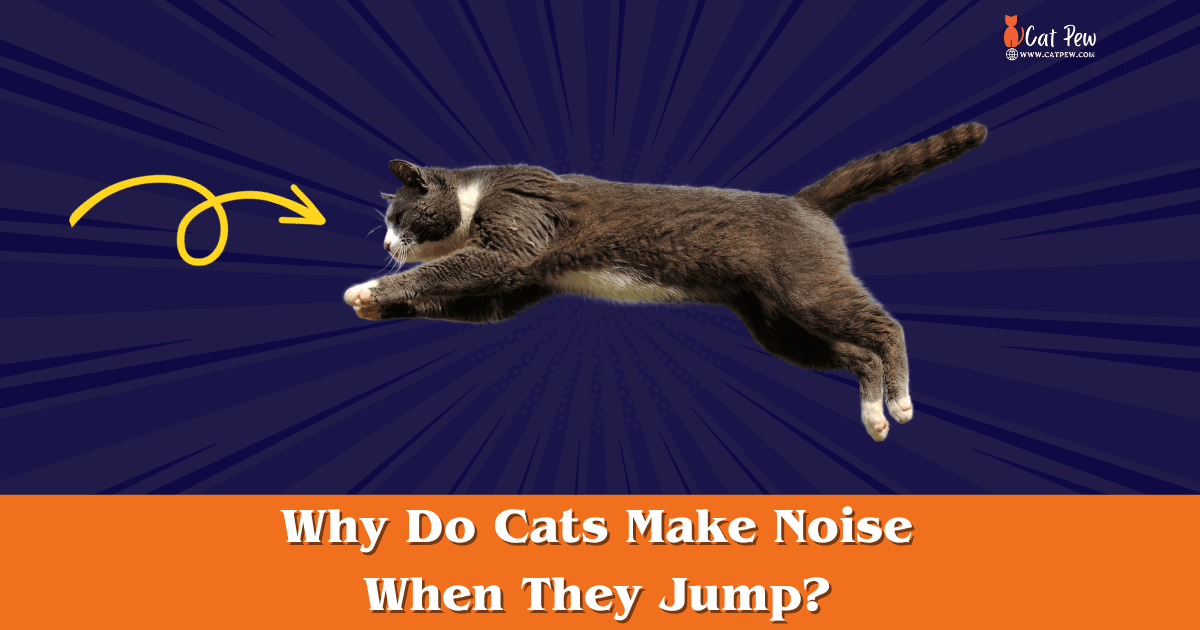Why Do Cats Make Noise When They Jump
Cats make noise when they jump due to their powerful muscles propelling them off the ground. When cats jump, they exert force and energy, causing a sound to be produced.
This noise can vary depending on the size and weight of the cat, as well as the surface they are jumping on. Understanding why cats make noise when they jump can provide insight into their agility and physical capabilities. Cats’ ability to generate sound through their jumps is an intriguing aspect of their behavior, and studying these movements can help us better understand their instinct to explore and move efficiently.
So, the next time you hear your cat making noise while leaping, you’ll know it’s simply their way of expressing their feline athleticism.
The Physiology Of Cats’ Jumping Ability

Cats emit noise when they jump due to their unique physiology. Their powerful hind legs and flexible joints allow them to generate force and propel themselves effortlessly, resulting in audible sounds as they leap.
Cats are remarkable creatures with an incredible ability to leap, pounce, and climb with grace and precision. Their innate jumping prowess is a result of their unique physiology, which has evolved over centuries to make them agile hunters and acrobats. In this article, we will explore the remarkable physiology behind cats’ jumping ability, delving into the muscular power, agility, and skeletal structure that allows them to execute their incredible leaps.
The Muscular Power Behind Cats’ Jumps
When it comes to jumping, cats rely on their powerful leg muscles, which are essential for generating the force needed to propel themselves into the air. The major muscles involved in their jumping ability are the hindlimb muscles, including the quadriceps and the gastrocnemius.
The quadriceps, located in the front of the thigh, are responsible for extending the cat’s leg, propelling them upward. These are the muscles that give cats the ability to push off the ground with incredible force, lifting their bodies into the air towards their intended target.
Additionally, the gastrocnemius muscles, located in the calves, provide cats with the ability to flex their feet and extend their lower legs, allowing them to achieve a higher jump. Together, these powerful leg muscles give cats the necessary strength and explosive power for their impressive vertical leaps.
Understanding Cats’ Remarkable Agility
While the muscular power of cats is a crucial factor in their jumping ability, their remarkable agility also plays a significant role. Cats possess a highly flexible spine, which allows them to twist, turn, and contort their bodies in mid-air, adjusting their trajectory and landing with precision.
Another contributing factor to their agility is their retractable claws. When cats jump, they extend their claws to gain traction on the surface they take off from, enabling them to push off with maximum force. Once they’re airborne, they retract their claws to prevent them from becoming caught on any obstacles mid-flight.
Furthermore, their well-developed vestibular system, which is responsible for balance and spatial orientation, assists in maintaining stability and orientation during their jumps. This system, combined with their heightened sensory perception and remarkable reflexes, allows cats to adapt to changes in direction and distance while in the air.
How Cats’ Skeletons Enable Jumping
Cats’ skeletons are optimized for jumping, providing a strong and flexible framework that supports their acrobatic movements. Their long hind limbs and flexible spinal column allow for greater extension and propulsion, giving them the ability to jump to impressive heights.
| Bone Structure | Function |
|---|---|
| Long Hind Limbs | Provide a longer lever arm for greater force generation. |
| Elongated Lumbar Vertebrae | Enable increased spine flexion during upward movements, enhancing jumping height. |
| Flexible Shoulder Girdle | Allows for a wide range of motion in forelimbs, aiding in balance and agility. |
In addition to these structural adaptations, cats have powerful pelvic muscles that assist in propelling their bodies during jumps. These muscles, along with their spring-like tendons and ligaments, act as powerful springs, storing and releasing energy to maximize their leaps.
Overall, the physiology of cats’ jumping ability is a fascinating blend of muscular power, flexibility, and skeletal adaptations. These extraordinary attributes allow cats to navigate their environment with remarkable agility and precision, making them exceptional climbers, hunters, and captivating companions.
The Different Types Of Cat Noises During Jumping

Have you ever wondered why your feline companion makes so much noise when leaping from one surface to another? Cats are naturally agile creatures, but their acrobatic prowess is often accompanied by an assortment of vocalizations. Understanding these different types of cat noises can give you insight into your furry friend’s emotions and needs.
Exploring The Range Of Vocalizations
Cats are not silent creatures by any means. They use a complex system of vocalizations to communicate various messages to their human companions and fellow felines. While meowing is the most common sound associated with cats, it is not the only noise they make.
During jumps, cats can produce an array of noises, ranging from soft chirping to high-pitched yowling. These sounds are influenced by factors such as the cat’s breed, age, personality, and the height or distance of the jump. By deciphering these sounds, you can gain a deeper understanding of your cat’s behavior and feelings.
Decoding The Meaning Behind Each Noise
Each type of cat noise during jumping conveys a distinct message. By familiarizing yourself with these vocalizations, you can respond appropriately to your cat’s needs and provide them with the necessary support and care.
| Noise | Meaning |
|---|---|
| Purr | Contentment and satisfaction. Your cat is happy and confident in their jump. |
| Chirp | Excitement and anticipation. Your cat is enthusiastic about the jump and ready to explore. |
| Yowl | Discomfort or pain. Your cat may be experiencing physical distress during the jump. |
| Hiss | Warning or aggression. Your cat may feel threatened or territorial during the jump. |
Understanding the meaning behind each noise can help you ensure the safety and well-being of your cat during their jumps. If you notice any unusual or concerning sounds, it is advisable to consult with a veterinarian to rule out any underlying health issues.
Common Cat Noises When Jumping Explained
While every cat is unique, there are several common noises you may observe when your furry friend leaps from one surface to another. Here are some of the most frequently encountered cat noises during jumping:
- Meow: This versatile sound can have different meanings, ranging from a simple greeting to a call for attention or assistance during a jump.
- Squeak: A high-pitched noise often associated with kittens. It signifies excitement or surprise during a jump.
- Growl: An intimidating noise that warns others to stay away. Cats may growl during jumps if they feel threatened or cornered.
- Whine: A plaintive cry indicating dissatisfaction or discomfort. Your cat may whine during a jump if they are unsure or hesitant about the landing surface.
By recognizing these common cat noises, you can foster a stronger bond with your feline companion and ensure their jumping experiences are safe and enjoyable.
The Reasons Behind Cats Making Noise When They Jump

Cats make noise when they jump due to the impact and the way their muscles and joints work. The sound is caused by their paws hitting the ground and their claws gripping surfaces for balance.
Alerting Prey Or Communicating With Other Cats
When cats make noise while jumping, it can serve various purposes. One of the reasons behind this behavior is their instinctual need to communicate with other cats or alert potential prey. Cats are known for being stealthy hunters, and their jumping noises can be a way of letting other cats know about their presence in the area or establishing territory. It can also serve as a warning to potential prey, signaling that the cat is nearby and ready to pounce. Furthermore, cats make specific sounds while jumping to communicate with their human owners. Some cats might meow or chirp during a jump as a way of seeking attention or letting their owners know about their movements. These vocalizations can also serve as a form of communication, indicating that the cat is happy, excited, or looking for interaction. Whether it’s a short ‘meow’ or a longer ‘chirp’, these noises allow cats to engage with their environment and communicate their needs.
Expressing Excitement Or Fear
Another reason why cats make noise when jumping is to express their emotions, particularly excitement or fear. Excited cats may let out chirps, and trills, or even develop a full-on ‘zoomie’ by running and leaping around the house. These noises can be an expression of their joy and eagerness to explore their surroundings. On the other hand, cats experiencing fear or anxiety might make more vocalizations when jumping as a result of feeling threatened or startled. These sounds can range from hissing or growling to loud yowls, indicating the cat’s discomfort or distress.
Psychological And Behavioral Factors Influencing Jumping Noises
Psychological and behavioral factors can also influence the noises cats make while jumping. Some cats have developed certain habits or learned behaviors that manifest as vocalizations during jumps. For instance, a cat that has been rewarded or reinforced with attention after making noise while jumping may continue this behavior in the future. This can create a conditioned response, linking jumping noises to desired outcomes, such as receiving attention or treats. Additionally, environmental factors play a role in the sounds cats make when jumping. A noisy household or surroundings can contribute to a cat’s tendency to vocalize during jumps. Cats are highly attuned to their surroundings and may use vocalizations to express their reactions to certain stimuli, such as loud noises or sudden movements. It is essential to consider the overall environment and any potential stressors that may influence a cat’s behavior during jumps. In conclusion, cats make noise when they jump for various reasons. Whether it’s to communicate with other cats, express their emotions, or due to learned behaviors, these vocalizations provide insights into their overall well-being. Understanding the reasons behind these jumping noises can help cat owners interpret their actions and strengthen the bond between human and feline companions. So next time your cat makes noise during a jump, pay attention to their signals and provide an environment that allows them to express themselves naturally.
How To Minimize Or Control Cat Noises During Jumping

If you find that your cat’s jumping noises are becoming a bit too much to handle, don’t worry! There are several training techniques you can implement to modify their jumping behavior. By providing them with positive reinforcement and redirecting their attention, you can help minimize or control those loud thuds. Here are a few effective strategies:
- Teaching alternative behaviors: Encourage your cat to use designated jumping areas by making them more enticing. Place toys, scratching posts, or cozy cushions near these areas to encourage them to land with less noise. Remember to reward them with treats or praise for using those designated spots.
- Clicker training: Using a clicker to reinforce desired behaviors can be an effective tool. When your cat jumps quietly, immediately click and reward them. This will help them associate quiet landings with positive reinforcement.
- Obstacle courses: Create obstacle courses or agility setups that require your cat to jump with control. Start with low-level challenges and gradually increase the difficulty as they become more skilled at landing quietly.
Certain environmental factors can contribute to the noise cats make when they jump. By identifying and addressing these factors, you can help reduce the impact of their jumps. Here are a few things to consider:
- Flooring type: Hard flooring surfaces like hardwood or tile can amplify the sound of your cat’s landing. Consider placing rugs or carpet runners in high-traffic areas to dampen the noise.
- Furniture placement: Rearranging furniture can help create a more conducive environment for quieter landings. Positioning items strategically can provide your cat with additional landing options less likely to cause a disturbance.
- Jumping height: If your cat frequently jumps from high surfaces, such as countertops or shelves, their landings are bound to be louder. Installing cat shelves or providing accessible alternatives can help reduce the impact.
Introduction To Cat Noise Reduction Tools And Strategies
In addition to training techniques and environmental adjustments, various tools and strategies are available to minimize cat noises during jumping. These can be particularly useful if you live in an apartment building or have sensitive neighbors. Explore the following options:
- Carpet or foam mats: Placing thick carpet or foam mats in the areas frequented by your cat can help absorb the sound of their jumps.
- Noise-reducing furniture pads: Attach noise-reducing pads to furniture surfaces that your cat jumps on frequently. These pads help dampen the impact and minimize the resulting noise.
- Soundproofing measures: Consider soundproofing specific areas or rooms where your cat spends a significant amount of time. Adding sound-absorbing materials to walls or using soundproof curtains can help reduce noise transmission.
By implementing these training techniques, addressing environmental factors, and utilizing noise-reduction tools or strategies, you can enjoy a quieter living space while still allowing your cat to engage in their natural jumping behaviors. Remember, consistency and positive reinforcement are key when modifying their behavior. Happy training!
Understanding And Responding To Cats’ Jumping Noises

As cat owners, we have all experienced those curious noises our feline friends make when they jump. Whether it’s a soft thump or a loud crash, these sounds can be intriguing, but have you ever wondered why cats make these noises? In this article, we will explore the reasons behind these jumping noises and discuss how to understand and respond to them in a way that strengthens our bond with our furry companions.
Building Stronger Bonds Through Understanding
To build a stronger bond with our cats, it is essential to understand their behavior and communicate with them effectively. When it comes to jumping noises, it is important to remember that cats are naturally agile creatures with incredible jumping skills. These noises can be a way for them to express their strength and playfulness, showcasing their athleticism.
By observing and understanding our cats’ behavior during these jumps, we can learn valuable insights about their personalities and needs. Some cats may make louder noises when jumping to get attention or assert their dominance, while others may do it purely out of excitement. Recognizing these behaviors can help us understand our cats on a deeper level and interact with them in a way that strengthens our bond.
Recognizing Signs Of Discomfort Or Pain
While most jumping noises are harmless and simply a result of your cat’s instincts, it is also important to be aware of any signs of discomfort or pain. Cats may sometimes make noise when jumping if they are experiencing physical discomfort or injuries. It is crucial to observe their body language and look for any signs of distress.
If you notice your cat consistently making noises accompanied by a change in behavior, such as limping or avoiding certain activities, it is advisable to consult with a veterinarian. They will be able to evaluate your cat and provide appropriate treatment if necessary. Remember, being proactive and addressing any potential health issues promptly is crucial for your cat’s well-being.
Ways To Comfort And Support Cats During Jumping Noises
If your cat’s jumping noises are simply a result of their playful nature, there are several ways to comfort and support them. Firstly, providing enough mental and physical stimulation through interactive toys and playtime can help alleviate their excess energy and reduce the need for excessive jumping.
Creating a safe and comfortable environment is also essential in minimizing any potential accidents or mishaps. Ensure that furniture and surfaces are stable, and consider providing soft landing spots for your cat, such as blankets or cushions near their favorite jumping spots.
Additionally, by maintaining a calm and reassuring presence during their jumping activities, you can instill a sense of security and trust in your cat. Avoid scolding or punishing them for making noises, as this can lead to anxiety and strain the bond between you.
Remember, every cat is unique, and understanding their individual preferences and needs is key to providing the care and support they require. By focusing on building a strong bond, recognizing signs of discomfort or pain, and offering comfort during jumping noises, you can create a harmonious environment for your beloved feline companion.
Frequently Asked Questions On Why Do Cats Make Noise When They Jump
Why Does My Cat Make A Brrr Sound?
Cats make a “brrr” sound when they are purring. It’s a way for them to communicate contentment and relaxation.
Why Does My Cat Jump At Loud Noises?
Cats jump at loud noises because they have sensitive hearing and are easily startled. It’s an instinct for them to react and seek safety when they perceive a potential threat or disturbance.
Why Do Cats Make That Weird Noise?
Cats make weird noises because they use vocalizations to communicate with humans and other cats. These sounds can include meowing, purring, hissing, and growling. The noises they make can indicate different emotions, needs, and behaviors.
Why Does My Cat Make A Whining Sound?
Cats make whining sounds to communicate their needs or wants. It could indicate hunger, discomfort, or a desire for attention. Observe your cat’s body language and behavior for further clues. If the whining becomes excessive or if you’re unsure, consult with a veterinarian to ensure your cat’s well-being.
Conclusion
Cats making noise when they jump is a natural behavior that serves multiple purposes. From communicating with humans to establishing dominance or seeking attention, these vocalizations are a part of their repertoire. Understanding the reason behind their sounds can help us better comprehend our feline friends and strengthen our bond with them.
So, next time you hear your cat making noise while jumping, remember it’s their way of expressing themselves.

Winston
I'm Winston, the author of this feline-focused (Catpew.com) blog . My love for cats goes back to my childhood, when I spent countless hours playing with my family's tabby, Mittens. This furry friend instilled in me a deep appreciation for the unique personalities, playful nature, and unconditional love that cats offer.

